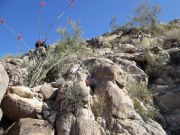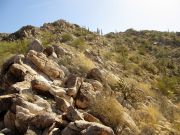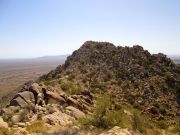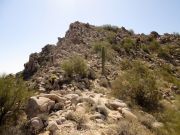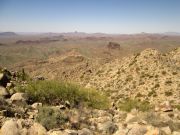
The Mountains of Arizona
• www.surgent.net
|
| Belmont Benchmark |
• Highpoint: Belmont Mountains • Hassayampa Plain • Maricopa County |
|
Date: April 14, 2018
• Elevation: 3,137 feet
• Prominence: 1,137 feet
• Distance: 8 miles
• Time: 6 hours
• Gain: 1,360 feet
• Conditions: Clear, cool at first then warm later
• Teammates: Matthias Stender
Arizona
•
Main
•
AZ P1K
•
PB
We had a short spell of cool weather for mid-April, so Matthias and I kicked around ideas for a peak to climb. After lobbing a few choices back and forth, we settled on Belmont Benchmark, the highpoint of the Belmont Mountains, about 60 miles west of Phoenix. For me, it would be my second attempt at this peak, and I was eager to retry it after a frustrating experience back in 2012, almost exactly six years to the day.
The Belmont Mountains are not unlike most desert ranges, with steep, brushy and rubbly slopes, and a mix of rock outcrops and cliffs. The Belmonts appear to be an uplifted range, as from up high, you can see the layers on the south-facing slopes and the cliffs they form when uplifted, on the north-facing slopes. The main range crest is narrow and rocky, with steep slopes both north and south. The north slopes are too steep to be hiked safely, leaving a southerly approach the only option. From the summit, ridges trend to the northwest, southwest and southeast.
In 2012, I came here and tried to hike the summit via the northwest ridge. This ridge did not look too bad from a distance, and it was closest to my vehicle, so it made most sense to try this ridge. However, about half-way up, cliffs block the way, too sheer and exposed to be climbed safely. I was able to scoot down and bypass them, but this meant dealing with nasty slopes of fist-size rubble and dense cactus fields. It was a nightmare.
I was able to will myself up one last chute to what appeared to be the top. By this point, I was out of patience with the hike, having slipped, slid and mashed parts of my body into rocks and cholla cactus too many times to count. I successfully surmounted this summit, hoping it was the true summit. But it was not. It was merely the westernmost bump along the summit ridge. The actual summit was about a thousand feet to the east, about 60 feet higher, but between me and it was a rocky ridge that, in my mindset at that moment, was too much for me to contemplate. I basically threw up my hands, said a few choice words, and decided to bail.
In retrospect, I regretted not gutting out that final portion from the western bump to the true summit. I had climbed much more challenging terrain many times before then. But at that very moment, in the foul mood I was in, I wasn't mentally up for more rocks and scrambling. I let it beat me. So today was an excellent opportunity to climb this peak properly, in a better mindset. We'd follow a different ridge, but the final segment from the western bump to the main summit would be the same.
I met Matthias at 6 a.m. at the Wal Mart parking lot off Dysart Avenue in Goodyear. I drove us from there to the 339th Avenue Exit off Interstate-10. We went north, then west, then north onto 355th Avenue, this being the Wickenburg-Vulture Mine Road that eventually leads to Wickenburg, about 40 miles to the north. I followed this road about 15 miles to a junction, the right going to Wickenburg, a left going south into the Belmont Range.
I drove south on good dirt road for 4 miles, parking in a clearing about a mile northwest of the summit. I could have driven farther, but wanted to play it safe with my vehicle. We got suited up and were walking at 7:20 a.m., the day cool and clear, no clouds anywhere, the temperature about 60 degrees.
We walked south for a couple miles into the range, passing the main summit on our left, aiming for a rocky mount up ahead called Belmont Mountain. The nomenclature is a little curious, since this bump gets this name, while the range highpoint is called Belmont Benchmark (or Belmont Peak). In any case, we took a left at a Y-junction, climbing somewhat steeply up lesser tracks that led to an old mine shaft. We carefully walked around this and surmounted the ridge, this being the main south-southwest ridge to the summit. There was no way I was going to mess with that northwest ridge again.
Once on this ridge, we started following it upward. Our way was blocked more than once by cliffs or rock outcrops, but we were always able to find ways around these obstacles. The slopes were relatively bare of brush, but sometimes steep with loose rubble. For the next hour or so, we slowly inched upward through the rocks and slopes. Toward the top, we came to a cliffy rock jumble. Here, we found small cairns which helped us follow a good line, so that the climbing was never more than class-2. It was exposed in spots, but never unsafe.
Now, we were below the last rock slope below the westernmost summit bump, the one I had visited back in 2012. We followed a couple more cairns which led us around to the right (looking up), then up a short stretch of steep slope to the range crest. The climbing here was loose in spots but safe. We used hands just to keep balance.
We still had to work through the rockpiles that line the summit ridge. We followed paths, then went up one steep chute of rocks, a gain of about 70 feet. Down the other side, we weaved through the rocks, dropping about 40 feet to the saddle below the actual summit. Everything looked far away, but after a minute of movement, things would be much closer. It's all in the head, they say.
Finally, we were below the final slope to the summit. The rocks here were big and mostly solid, forming steps that led to the top. We arrived at 10:15 a.m., Matthias' GPS saying we'd hiked 4.4 miles to get here. The day was warming up but was still pleasant. We had a breeze up this high, which helped. The air temperature was about 75 degrees, but it was sunny, so that it felt warmer when the air was still.
It felt good to be here, and put to rest my 2012 experience. We stayed up top for almost a half hour, reading the summit logs. I was amused to see someone had brought up a printout of my 2012 hike. It was folded up into the jar. Not many people had been here, about two or three teams per year. We had great views in all directions and enjoyed playing the "I climbed that peak" game. Surrounding peaks included the White Tank Range, Black Butte, Sugarloaf, Vulture, the Harquahala peaks, the Harcuvar Range, Big Horn, Burnt, Saddle, Palo Verde Hills, and Woolsey Peak. I've climbed all but Black Butte, Sugarloaf and Big Horn.
Going down, we slowly retraced our route through the summit ridge rocks, then down the steep scramble sections until we had dropped about 800 feet. We had spied possible bail routes from this ridge back to the road as we ascended, so when we saw a promising route down, we took it, rather than climb up one more bump and follow the lesser roads we'd followed in. Our bail route worked well, and we were soon back to the main road, which we simply trudged outward, back to my car. This didn't save us much mileage---about 0.8 mile---but it saved us probably 30 minutes of time.
The last mile or two was tedious and it was warm, but not that bad. My car's temperature gauge said it was about 82 degrees outside. It took us about two hours and fifteen minutes for the hike out. We changed clothes and started the drive back to the interstate. On the way, we saw a really tall, well-defined dust devil, its upper funnel about 200 feet into the air. I'd never seen one this well developed. I snapped an image of it (left sidebar) but it did not come out that well. Trust me, it was an impressive dust devil. Had there been a cow nearby, it would have been sucked right up into it.
We stopped at the TA Truck Stop at 339th Avenue and Interstate-10 for drinks and some Aleve for me. I then drove us back to the Wal Mart so Matthias could get his vehicle. I was back to my home about 3:30 p.m.. My thanks, as always, to Matthias for being a good partner on this hike.
The range is popular with 4-wheelers and people who like to explore mines. It doesn't get too many hikers. I think the south-southwest ridge we followed was ideal. It avoided the worst of the rubbly slopes that I had encountered on the northwest ridge years ago. It was still a loose hike, probably a shade sloppier than most desert peaks, but it ultimately wasn't too bad.
|
|



